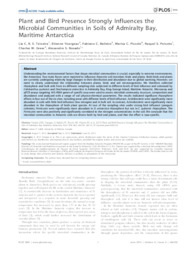Plant and bird presence strongly influences the microbial communities in soils of admiralty bay, maritime antarctica.
Plant and bird presence strongly influences the microbial communities in soils of admiralty bay, maritime antarctica.
Autoria: TEIXEIRA, L. C. R. S.; YEARGEAU, E.; BALIEIRO, F. de C.; PICCOLO, M. C.; PEIXOTO, R. S.; GREER, C. W.; ROSADO, A. S.
Resumo: Understanding the environmental factors that shape microbial communities is crucial, especially in extreme environments, like Antarctica. Two main forces were reported to influence Antarctic soil microbes: birds and plants. Both birds and plants are currently undergoing relatively large changes in their distribution and abundance due to global warming. However, we need to clearly understand the relationship between plants, birds and soil microorganisms. We therefore collected rhizosphere and bulk soils from six different sampling sites subjected to different levels of bird influence and colonized by Colobanthus quitensis and Deschampsia antarctica in Admiralty Bay, King George Island, Maritime Antarctic. Microarray and qPCR assays targeting 16S rRNA genes of specific taxa were used to assess microbial community structure, composition and abundance and analyzed with a range of soil physico-chemical parameters. The results indicated significant rhizosphere effects in four out of the six sites, including areas with different levels of bird influence. Acidobacteria were significantly more abundant in soils with little bird influence (low nitrogen) and in bulk soil. In contrast, Actinobacteria were significantly more abundant in the rhizosphere of both plant species. At two of the sampling sites under strong bird influence (penguin colonies), Firmicutes were significantly more abundant in D. antarctica rhizosphere but not in C. quitensis rhizosphere. The Firmicutes were also positively and significantly correlated to the nitrogen concentrations in the soil. We conclude that the microbial communities in Antarctic soils are driven both by bird and plants, and that the effect is taxa-specific.
Ano de publicação: 2013
Tipo de publicação: Artigo de periódico
Unidade: Embrapa Solos
Palavras-chave: Maritime antarctica, Microbial communit
Observações
1 - Por padrão são exibidas publicações dos últimos 20 anos. Para encontrar publicações mais antigas, configure o filtro ano de publicação, colocando o ano a partir do qual você deseja encontrar publicações. O filtro está na coluna da esquerda na busca acima.
2 - Para ler algumas publicações da Embrapa (apenas as que estão em formato ePub), é necessário ter, no celular ou computador, um desses softwares gratuitos. Sistemas Android: Google Play Livros; IOS: iBooks; Windows e Linux: software Calibre.
Acesse outras publicações
Acesse a Base de Dados da Pesquisa Agropecuária (BDPA) para consultar o acervo completo das bibliotecas da Embrapa.

